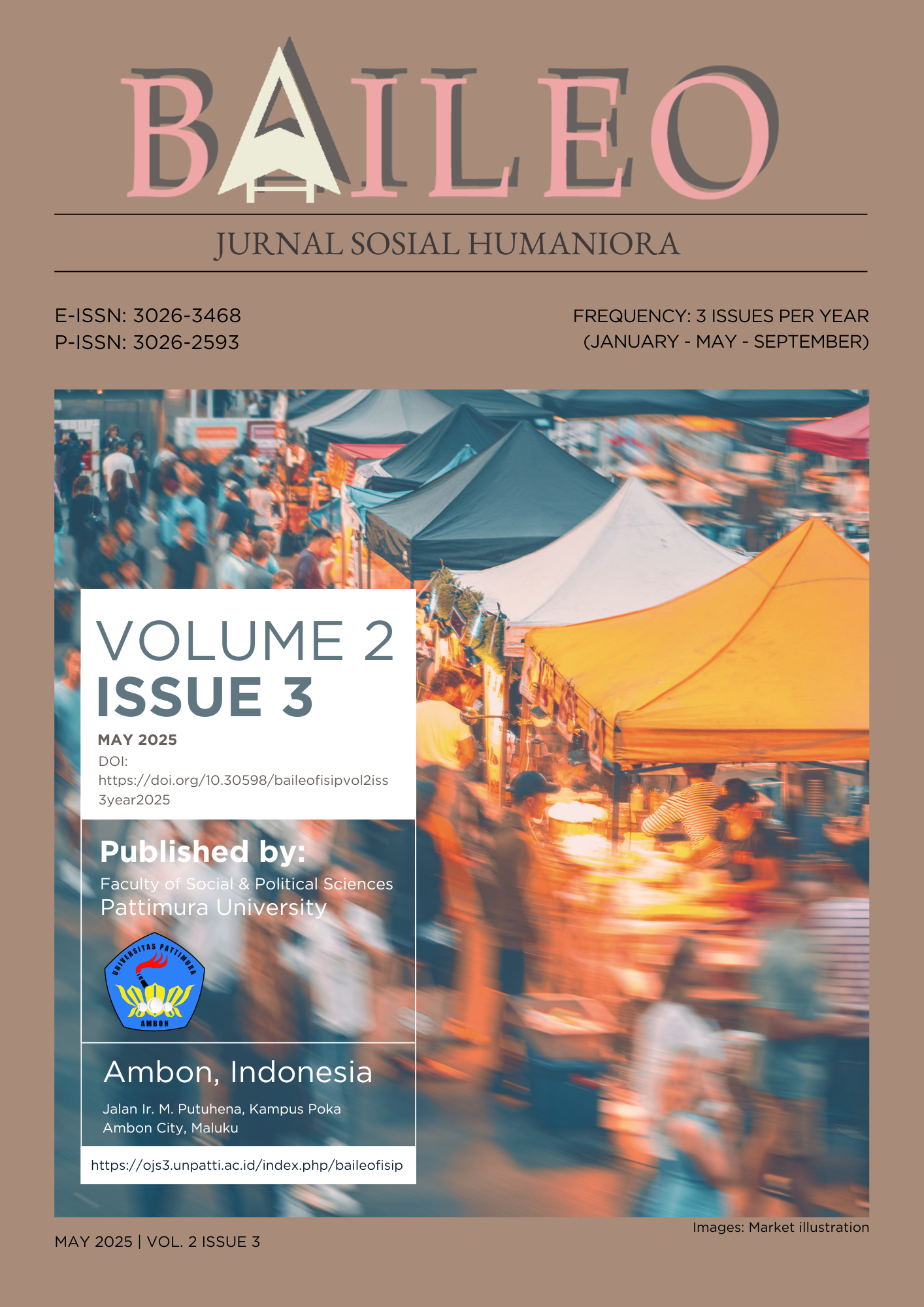Symbol, Sacrality, And Sociality: The Social Construction of The Meaning of Wedding Rings in Christian and Muslim Customary Communities in Maluku
Abstract
This article examines the social construction of the meaning of wedding rings within two culturally and religiously distinct customary communities in Maluku: Negeri Amahusu (predominantly Christian) and Negeri Batu Merah (predominantly Muslim). The primary aim is to explore how wedding rings—as marital symbols—are interpreted differently within each community’s social, religious, and cultural context. Employing a qualitative approach and grounded in the social construction theory of Peter L. Berger and Thomas Luckmann, this study draws on in-depth interviews, participant observation, and document analysis conducted in both communities. The findings reveal that the wedding ring is not merely a romantic or legal symbol but is regarded as a sacred object embodying religious values, communal morals, and social identity—shaped and transmitted through family practices, religious narratives, and intercultural interactions. The novelty of this study lies in its cross-community reading of a shared symbol, highlighting how marriage symbols serve as intersubjective mediums for transmitting collective values. The study concludes that cultural symbols like wedding rings play a crucial role in fostering social cohesion and promoting interfaith understanding in multicultural societies. It recommends strengthening intercultural studies in the social sciences and humanities to deepen insights into symbolic dynamics within pluralistic communities.
Downloads
References
Afdhal, A. (2024). Education and Peacebuilding: Cultural Values as the Foundation for Conflict Resolution in Schools. RISOMA : Jurnal Riset Sosial Humaniora Dan Pendidikan, 2(6), 68–87. https://doi.org/10.62383/risoma.v2i6.389
Alfons, C. R., & Titaley, E. (2024). Orang Haria and Marriage Customs: The Reality of Socio-cultural Order in the Maluku Archipelago. KnE Social Sciences. https://doi.org/10.18502/kss.v9i31.17565
Balani, S. (2023). What’s love got to do with it? Marriage and the security state. Identities, 30(2), 257–275. https://doi.org/10.1080/1070289X.2021.1949814
Berger, P. L., & Luckmann, T. (1966). The Social Construction of Reality: A Treatise in the Sociology of Knowledge. In Anchor Books (3rd ed.). Doubleday Garden City.
Carter, J. (2022). Traditional Inequalities and Inequalities of Tradition: Gender, Weddings, and Whiteness. Sociological Research Online, 27(1), 60–76. https://doi.org/10.1177/1360780421990021
Edwards, R., & Holland, J. (2020). Reviewing challenges and the future for qualitative interviewing. International Journal of Social Research Methodology, 23(5), 581–592. https://doi.org/10.1080/13645579.2020.1766767
Friedland, R., Roose, H., & Mohr, J. W. (2025). The institutional logics of love: the order of passion in an intimate field. American Journal of Cultural Sociology, 13(1), 1–52. https://doi.org/10.1057/s41290-024-00209-9
Gaspersz, S. G. C., & Souisa, N. N. (2023). Negotiating Religious Identities and Modernity in Maluku: A Socio-Historical Perspective. Religió Jurnal Studi Agama-Agama, 13(1), 41–69. https://doi.org/10.15642/religio.v13i1.2260
Huda, M. C., & Muhsin, I. (2022). Liminality Rituals of Interfaith Families: Symbolic Interactionism and Maqāshid Sharia Perspectives. Ulul Albab: Jurnal Studi Dan Penelitian Hukum Islam, 5(2), 1. https://doi.org/10.30659/jua.v5i2.20488
Idrus, A. M., Nurdin, R., Qayyum, R., Halim, P., & Amir, R. (2023). The Tradition of Mappasikarawa in the Bugis-Makassar Community Marriage: A Study of Islamic Law Philosophy. Samarah: Jurnal Hukum Keluarga Dan Hukum Islam, 7(2), 848. https://doi.org/10.22373/sjhk.v7i2.17125
Iye, R. (2022). The Symbolic Meaning of Wedding Offerings in Buru Island. Sang Pencerah: Jurnal Ilmiah Universitas Muhammadiyah Buton, 8(1), 202–209. https://doi.org/10.35326/pencerah.v8i1.1797
Jingyi, X., & and Jiangli, Z. (2024). Religion, culture, and identity: the generational evolution of identification with Buddhism from the perspective of young Chinese Indonesians. International Journal of Children’s Spirituality, 29(3–4), 103–139. https://doi.org/10.1080/1364436X.2024.2380253
Jung, M. (2024). Imagining sovereign futures: the marriage equality movement in Taiwan. Social Movement Studies, 23(4), 462–478. https://doi.org/10.1080/14742837.2021.2010528
Kalay, N. S. (2024). Segregation, Identity, and Trauma: Muslim-Christian Engagement in Post-Conflict Ambon, Indonesia [Vrije Universiteit Amsterdam]. https://doi.org/10.5463/thesis.319
Lakawa, S. E. (2024). Bible Study as Postcolonial Witnessing. International Review of Mission, 113(1), 68–91. https://doi.org/10.1111/irom.12490
Lambert, V. A., & Lambert, C. E. (2021). Qualitative descriptive research: An acceptable design. Pacific Rim International Journal of Nursing Research, 16(4), 255–256.
Latupono, B., Kuahaty, S. S., & Pesulima, T. L. (2023). Settlement of Marital Problems By Using The Traditional Institutions of Married Brothers. SASI, 29(2), 310. https://doi.org/10.47268/sasi.v29i2.1348
Lim, W. M. (2024). What Is Qualitative Research? An Overview and Guidelines. Australasian Marketing Journal. https://doi.org/10.1177/14413582241264619
Lipska, A., & Zagórska, W. (2021). Crossing the threshold. Emerging adulthood as an elaborate liminal phase of the rite of passage. Kwartalnik Naukowy Fides et Ratio, 46(2), 7–26. https://doi.org/10.34766/fetr.v46i2.838
Mäder, M.-T. (2023). Promising images of love: a qualitative-ethnographic study about the mediatised memories of weddings. Open Research Europe, 3, 198. https://doi.org/10.12688/openreseurope.16521.1
Manuputty, F., Afdhal, A., & Makaruku, N. D. (2024). Membangun Keluarga Harmonis: Kombinasi Nilai Adat dan Agama di Negeri Hukurila, Maluku. Jurnal Ilmu Sosial Dan Humaniora, 13(1), 93–102. https://doi.org/10.23887/jish.v13i1.73080
Meler, T., & Marnin-Distelfeld, S. (2024). Marriage and motherhood: Insights on a crucial life course process from the perspective of female arab-palestinian undergraduate students. Advances in Life Course Research, 60, 100614. https://doi.org/https://doi.org/10.1016/j.alcr.2024.100614
Mensah, R. O., & and Korankye, V. (2025). The Role of Fashion in Crime Symbolism in Ghana, West Africa. Deviant Behavior, 46(3), 347–364. https://doi.org/10.1080/01639625.2024.2346330
Muchimah, Jahar, A. S., Hamdani, & Fajarini, U. (2024). Legal Culture and the Dynamics of Religious Interaction in Ritual Practices among Interfaith Marriage . Al-Manahij: Jurnal Kajian Hukum Islam, 18(2 SE-ARTICLES), 333–348. https://doi.org/10.24090/mnh.v18i2.11659
Naeem, M., Ozuem, W., Howell, K., & Ranfagni, S. (2024). Demystification and Actualisation of Data Saturation in Qualitative Research Through Thematic Analysis. International Journal of Qualitative Methods, 23. https://doi.org/10.1177/16094069241229777
Natow, R. S. (2020). The use of triangulation in qualitative studies employing elite interviews. Qualitative Research, 20(2), 160–173. https://doi.org/10.1177/1468794119830077
Nur Fadilla, Mayasari Mayasari, & Hidayati Hidayati. (2024). The Symbolic Meaning In Minangkabau Bukittinggi Traditional Wedding : Semiotics Studies. Sintaksis : Publikasi Para Ahli Bahasa Dan Sastra Inggris, 2(1 SE-Articles), 149–159. https://doi.org/10.61132/sintaksis.v2i1.289
Overton, W. F. (2023). Contexts of Meaning: The Computational and the Embodied Mind. In The Nature and Ontogenesis of Meaning (pp. 1–18). Routledge. https://doi.org/10.4324/9781003428152-1
Park, J. Y. (2021). Symbolic Meanings in the Wedding Ring in the Merchant of Venice: Religious Conflicts and Matriarchal Challenge. ANQ: A Quarterly Journal of Short Articles, Notes and Reviews, 34(2), 97–104. https://doi.org/10.1080/0895769X.2019.1622073
Parkins, I., & and Findlay, R. (2021). Commodity Feminism and Dressing the ‘Best Self’ on A Practical Wedding. Australian Feminist Studies, 36(109), 297–312. https://doi.org/10.1080/08164649.2021.2018992
Said, W., Hukmiah, H., Nur, S., Wahyuni, S., & Akbar, R. (2024). Marriage Traditions and Family Resilience in Bugis Bone Society: A Study of Islamic Law and Islamic Education. Samarah: Jurnal Hukum Keluarga Dan Hukum Islam, 8(3), 1372. https://doi.org/10.22373/sjhk.v8i3.23227
Tan, R. S.-E., Ng, M. L., Wan Mokhtar, W. K., Deng, P. F., & Zhang, J. (2024). Between Tradition and Faith: Navigating Identity Transformations of Chinese Muslim Women in Malaysia and China BT - Muslim Women’s Lived Experiences and Intersectional Identities: A Global Perspective (P. M. Wan, S. A. Qureshi, & R. B. M. Hussain (eds.); pp. 283–308). Springer Nature Switzerland. https://doi.org/10.1007/978-3-031-75729-7_15
Thaib, E. J., Nusi, A., & Suharti. (2021). Da’wah in Multicultural Society; Struggling between Identity, Plurality and Puritanity: an Empirical Study of Cheng Hoo Mosque of Makassar, South Sulawesi. Al-Ulum, 21(1), 89–106. https://doi.org/10.30603/au.v21i1.2111
Turner, M. (2023). Design for a Theory of Meaning. In The Nature and Ontogenesis of Meaning (pp. 91–107). Routledge. https://doi.org/10.4324/9781003428152-4
Yusuf, M. (2024). Integration of Islamic Law into Local Governance: the Impact of Datuk Tellue’s Da’wah in South Sulawesi. NUKHBATUL ‘ULUM: Jurnal Bidang Kajian Islam, 10(2 SE-Articles). https://doi.org/10.36701/nukhbah.v10i2.1493
Zhang, H., Li, R., Chen, X., & Yan, F. (2024). Cultural representation in foreign language textbooks: A scoping review from 2012 to 2022. Linguistics and Education, 83, 101331. https://doi.org/https://doi.org/10.1016/j.linged.2024.101331
Zuhri, A. M., Wahyudi, W. E., & Hamid, A. (2021). Chinese Muslims’ Ways of Being Nationalist: Combining Islamic Cosmopolitanism, Acculturation and Social Roles. QIJIS (Qudus International Journal of Islamic Studies), 9(2), 279. https://doi.org/10.21043/qijis.v9i2.9649
Copyright (c) 2025 Lusanra Jacqueline Tutkey, Paulus Koritelu, Fransina Matakena

This work is licensed under a Creative Commons Attribution 4.0 International License.




